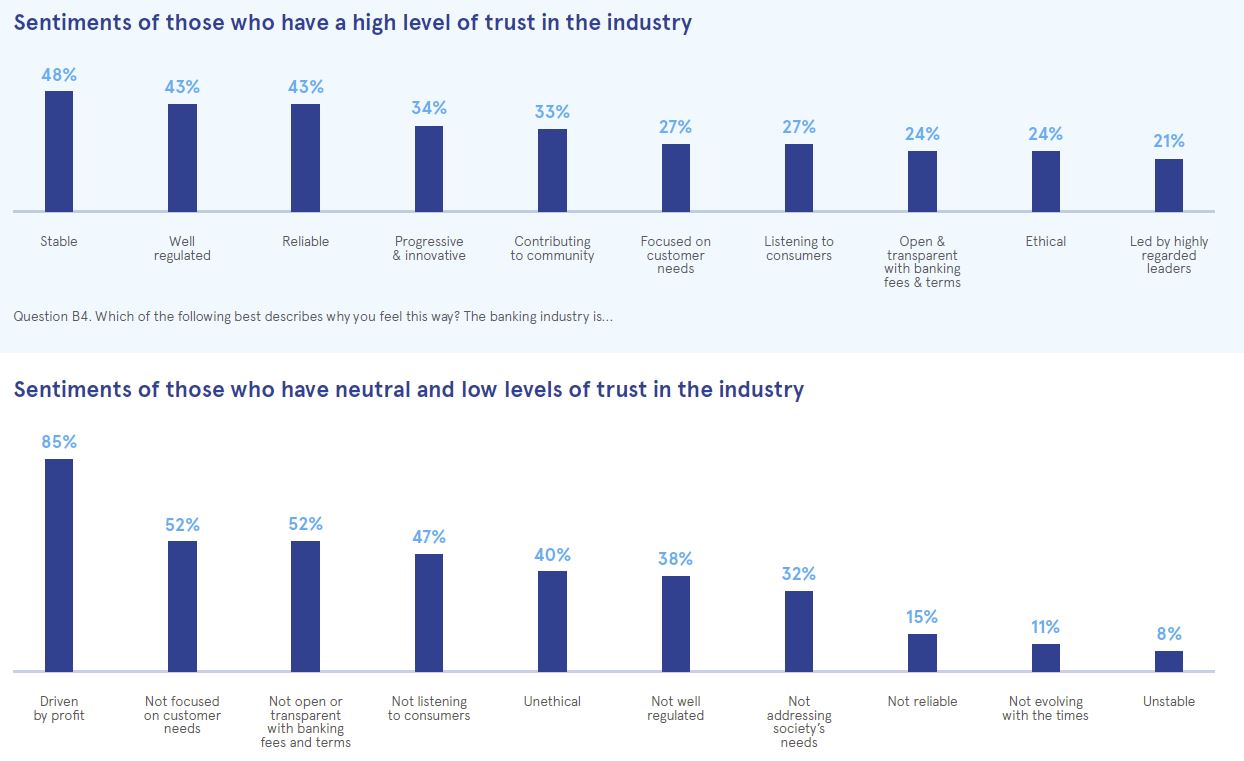The Australian Bankers’ Association has today released new research that measures and tracks community trust and confidence in banks.
Less than one third of those surveyed had high levels of trust in the banking industry. This is below the international benchmark.
 There are significant differences in attitude between those who have higher levels of trust, and those who do not. Those with low trust scores believed the banks were drive by profit, not focussed on customer needs and had terms and conditions which are not transparent.
There are significant differences in attitude between those who have higher levels of trust, and those who do not. Those with low trust scores believed the banks were drive by profit, not focussed on customer needs and had terms and conditions which are not transparent.
The research conducted by international firm Edelman Intelligence will be used by the industry to assess the impact of the wide ranging reform agenda currently underway across the sector.
“The research shows low levels of trust, confidence and transparency in the banking industry with a clear need for improvement,” according to ABA Chief Executive Anna Bligh.
“Interestingly, survey respondents report stronger levels of trust with their own personal banking experience (53 per cent) than they do with the industry as a whole (31 per cent).
“This points to a real opportunity for banks to translate the experience customers have with their own bank into higher levels of trust in the sector as a whole,” she said.
The Edelman Intelligence research has also measured the community’s knowledge of current industry-led banking reforms and their views of these reforms.
“While awareness of the reforms is low, respondents have a clear view that the reforms are on the right track to improve banking culture and customer experience,” Ms Bligh said.
“It is heartening that while challenges lie ahead for banks, customers are receptive to banks’ massive reform program.
“As a result of more than 20 inquiries, reviews and investigations into banks in the past two years, Australia’s banks are now implementing one of the largest reform programs in their history.
“Along with Federal Government reforms such as the new Banking Executive Accountability Regime, a new one-stop shop for complaints and substantial improvements to contracts for small business lending, the industry has initiated its own reforms which include a new Code of Banking Practice, new whistleblower protections and changes to staff remuneration.
“It’s a big program of transformation and future benchmarking will look at the full breadth of changes that are underway,” Ms Bligh said.
Anna Bligh will today outline to the Good Shepherd Microfinance Conference in Melbourne the importance of measuring and benchmarking trust in banks.
“It is critical to the whole banking industry that real progress is made in rebuilding trust and respect with the community,” she said.
“The fact that this research has been done, that it is being set as a tangible benchmark and being made public, is an indication the banking sector is serious about reform and prepared to be held accountable.”
Key findings from the report include:
- When asked to rate the importance of the initiatives in making banking better, each initiative scored between 62 and 75 per cent.
- The initiatives that will have the greatest impact on trust are strengthening the Code of Banking Practice and changing the way bank staff are paid.
- Respondents are most aware of actions their main bank has taken in relation to the removal of individuals from the industry for poor conduct (53 per cent), followed by a strengthening of commitment to the Code of Banking Practice (51 per cent).
- Based on the 2017 Edelman Global Trust Barometer, Australians’ trust in the financial services sector has increased slightly, but is still four points behind the global average.
“Banks are trusted when they’re considered stable, well-regulated and reliable. This research shows just how much more work needs to be done before trust in bank culture and conduct reach stronger levels than seen in this research,” Ms Bligh said.
“The research will be conducted regularly to assess progress and identify areas for further reform.”
The Edelman Intelligence research consisted of an online survey of 1,000 Australians and 12 focus groups between May and June 2017. More information is available in the report.

